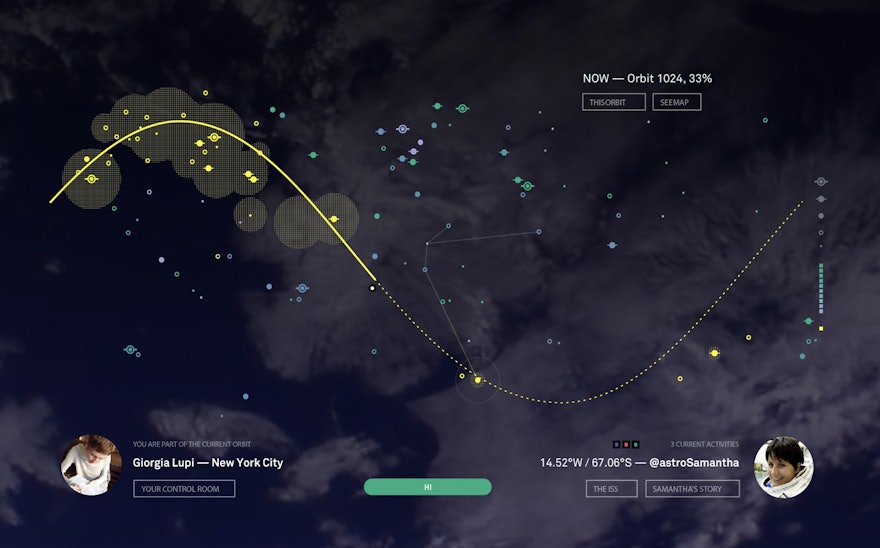Samantha Cristoforetti is the first Italian woman who traveled to the International Space Station (ISS) as an astronaut for the European Space Agency. A Twitter conversation between Samantha and Pentagram partner Giorgia Lupi and her team at Accurat began in early 2014, while Sam was preparing for her mission. The conversation led to Sam asking if the data from her mission could be used to reach out to people as she flew above them.
Their imagination sparked by this unique opportunity, the design team agreed to create a special interactive experience using data from the mission. They conceived and developed a web-based digital app that integrated real-time data streams from the ISS within a visual interface that could be used simultaneously by thousands of people around the world.
A mission to the ISS generates terabytes of data, so there was more material than the design team could use. They realized, though, that people don’t want mere data, they want the human story behind the information, and to feel part of a great achievement like space travel. The story was that Samantha was up there: a human being in a tin box flying in outer space, something that could be seen with the naked eye on a clear night.
The design team used data to create a connection between Sam and the people looking up at her from below. Using a simple digital gesture within the app, a person could say “hello” to Sam when she was in orbit overhead, and “hello” to all of the other people around the world who were online at the same time. Ultimately, the team also allowed Sam to say “hello” back to the world using Twitter from the ISS. During its first three weeks online, Friends in Space hosted more than two million interactions, merging the physical, the digital, and the emotional in moments of joy and connection.
When a user logged in from Facebook, Twitter, or Google+, they could see Samantha’s real-time position in the sky, as well as a map of all the users on the platform at that moment. The visualization is a universe of dynamic colored dots over a world map, like planets and constellations hovering around the yellow trace of ISS’s orbit. Each dot indicates an individual user active on Friends in Space. A beautiful image of the Earth seen from above appears in the background.
The app offers three explorable environments, the now, the past, and the future. These allow users to explore Samantha’s mission in real-time or go back and forth to see what has already happened and what she will be doing next. During the six months that Friends in Space was live, thousands of people from all over the world connected with one another and continued the conversation on social media.
Placing users and Samantha in the same picture and acknowledging her presence and location encouraged people to see data from a very different perspective: it became more about people and curiosity than numbers and technology. Friends in Space illustrated how digital connections among people could be visualized in an aesthetically pleasing way while also leaving room for imagination and wonder.
Friends in Space was also an homage to the ancient tradition of looking up at the sky together. Throughout the centuries, people have looked to the stars to help them navigate across open oceans or featureless deserts, know when to plant or harvest, and preserve their myths and folklore. In its immensity, it continues to provide a blank canvas for imagination, dreams, and stories.
Self-funded by the design team, Friends in Space was online from November 24, 2014 to June 11, 2015, and the app was featured prominently in Wired, Vogue, Fast Company, Fusion, Vanity Fair, Time, and other publications.

